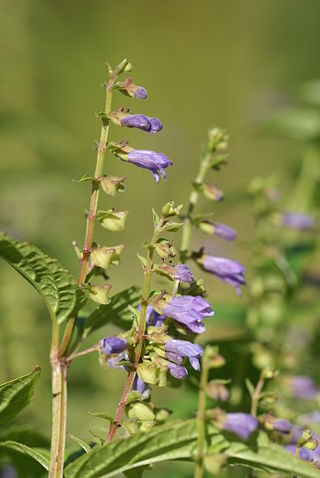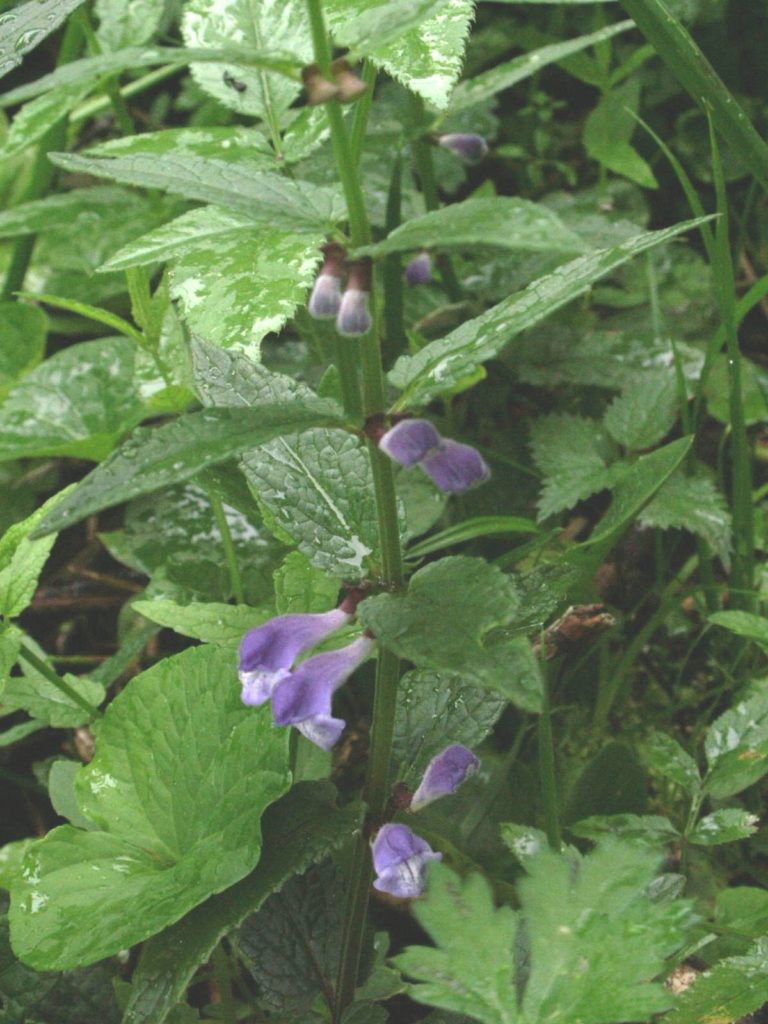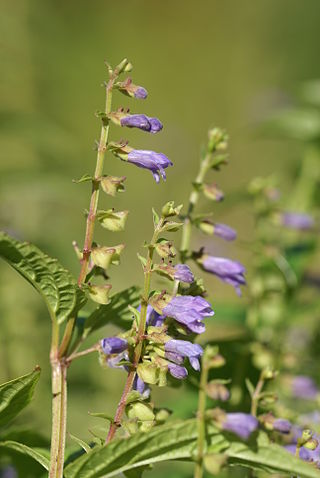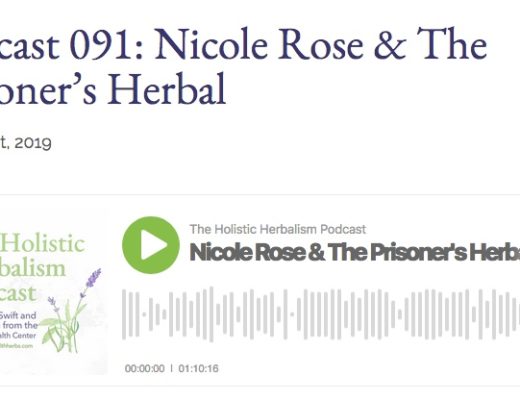Please note these plant profiles are a work in progress. I will always be adding to them as I keep learning about the amazing world of plant medicine.
Botanical Overview
Latin name: Scutellaria lateriflora (North America), Scutellaria galericulata (British Isles)
Plant family: Lamiaceae (mint family)
NB – There are more than 300 species of skullcap growing around the world used traditionally for many similar and different purposes. Scutellaria lateriflora is native to North America. It is used traditionally by the Cherokee Nation (Aniyvwiya) and was appropriated by settler colonialists. It is now widely cultivated (1).
In England, Wales, Scotland and Ireland, our native species are Scutellaria galericulata and Scutellaria minor. Another commonly used medicinal plant with differently used actions is Baikal Skullcap, Scuttelaria baicalensis that is native to Siberia and Asia. I have tried to use the Latin names to prevent confusion.
Identification: Scutellaria lateriflora plants are erect and multi-stemmed and grow 1-3ft tall from dense rhizomatous mats. Leaves are oval or lance-shaped, opposite and toothed and grow from petioles attached to square stems. Flowers range from white to violet-blue and grow on racemes attached to leaf axils along the length of the stems. Flowers are helmet-like sheaths (2).
Folk names in English: Please note most of these names are used for different skullcap species, some are also used for completely different plants. Hoodwort, Mad-dog, Madweed, Blue Pimpernel, Helmet Flower. Scutellaria lateriflora is also known as Virginian Skullcap and Blue Skullcap. Scutellaria galericulata is also known as Marsh Skullcap. ‘Scutella’ in Latin means “little dish” because of how the flowers have a dish-like and helmet-like shape.
Chemical constituents: Scutellaria lateriflora – flavonoid glycosides (including wogonin, baicalin), scutellarin, volatile oils, lignans, resins, diterpenoids, bitters, tannins, iridoids, phenols, B vitamins, minerals, iron, silica, calcium, potassium and magnesium (3).

Food and nutrition
Skullcap is generally used as a strong medicinal plant rather than a food. Research shows however that the plant is very high in zinc, high in potassium and vitamin C, as well as average quantities of iron, manganese, niacin, phosphorous, protein, riboflavin, silicon, thiamine and vitamin A (4).
Ecological role
Scutellaria lateriflora is generally found in damp places and meadows. As a wetland-loving species, it can be found in moist, shady, riparian habitats.
Scutellaria galericulata can also be found on damp ground, such as marshes, fens, riverbanks, pond margins and canal sides
Cultivation: Scutellaria lateriflora prefers moist soil with a high percentage of organic matter. Organic herb farmers, Melanie and Jeff Carpenter write, “Muck is a term often used to describe the soil where we find skullcap growing in the wild. This type of soil is prone to extended periods of being sodden, but unlike anaerobic swamps, muck soils dry out enough periodically to allow for oxygen to promote aerobic conditions.” They say that although skullcap loves rich soil, it does not perform well in soils with excessive amounts of nitrogen. Excessive nitrogen also greatly increases skullcap’s susceptibility to fungal diseases, such as powdery mildew.
Skullcap can be propagated by seed directly or via transplants. It can also be grown with vegetative cuttings. Skullcap is commonly harvested during the early stages of flowering. It is recommended to transplant Skullcap at 12-inch spaces in rows, 14inches part with 3 rows to a bed (2).
Energetics
- Temperature: Cooling
- Moisture: Drying
- Tissue State: Wind/Tension, Heat/Excitation
- Taste: Bitter
Health challenges supported by Skullcap (Scutellaria lateriflora unless otherwise stated):
Herbal actions: Antispasmodic, nervine, sedative, brain tonic, anti-depressant, anticonvulsant, anaphrodisiac, anodyne, antimicrobial, anti-inflammatory, vasodilator, cardiotonic, astringent, digestive, diuretic, emmenagogue, alterative, febrifuge (3).
Supporting the Nervous System: Skullcap is one of the most powerful allies to the nervous system available. Herbalist Alexis. J Cunningfolk writes: “Skullcap restores strength to an overwhelmed nervous system, relieving spasms, nerve pain, and cultivating calm. For nervousness, fear, and a sense of being overwhelmed, Skullcap stimulates the brain to produce more endorphins in the system due to the presence of scutellarin in the plant which becomes scutellarein in the body.” (6)
Skullcap is a nervine trophorestorative. Herbalist Sajah Popham describes these remedies as those which act to tonify, strengthen, and restore the proper structure and function of the nervous system. These are best used whenever there have been cases of shock, prolonged periods of stress or sleep deficit, longstanding anxiety, panic attacks, tension, or excessive use of stimulants. These are applicable to what the old doctors called “neurasthenia” or nervous debility.

Insomnia and nightmares: Skullcap can help settle a restless mind before sleep. The cold-infusion is strongly sedating and can help the nervous system prepare for sleep, resettling sleeping patterns over time.
Support during withdrawal from orthodox tranquillisers and antidepressants: Skullcap is said to aid the nervous system when withdrawing from benzodiazepines (7). (If you are a herbalist with experience of this – I would love to hear from you).
Pre Menstrual Tension: Skullcap’s support the nervous system makes it useful for premenstrual irritability, depression and mood swings.
Pain relief: Skullcap can bring pain relief to tension headaches, muscle pain, neuralgia, period pain and arthritis (3). I used it extensively when experiencing costochondritis (inflammation in the cartilage of the rib cage).
Spasms: Skullcap’s antispasmodic properties make it useful for twitching muscles, facial tics, tremors, Parkinson’s, restless leg syndrome, epilepsy (petit and grand Mal), cramps and palpitations (3).
Shingles: Herbalist Anne McIntyre uses skullcap for shingles due to its nervine and antimicrobial actions.
Supporting the digestive system: Skullcap’s bitter flavour stimulates the liver and can enhance appetite and digestion. As an antispasmodic, it can help reduce spasm and colic, relieve wind and bloating and settle nervous stomach aches.
Cystitis and irritable bladder: Skullcap’s diuretic action makes it useful for treating cystitis and irritable bladder, particularly where there is a nervous component (3).
Cautions
Skullcap can sometimes be adulterated or mistakingly mixed with the germander species, Teucrium chamaedrys and Teucrium canadense. This has resulted in hepatotoxicity (liver toxicity) (5). Herbalist should also be aware of its hypnotic and anxiolytic drug enhancement properties and potential interactions with other sedative or tranquillising medicines.
Skullcap and the Solidarity Apothecary
Skullcap is perfect for the type-A organiser personality, who carries tension tight in their bodies and whose mind never stops thinking. For people recovering from the traumatic stress of state repression, I have sent them dried Skullcap for evening tea to settle their sleep patterns and reduce nightmares. I have also used it personally for long periods to recover from costochondritis and cope with intense chronic stress while my best friend fought for cancer treatment in prison.
Sources
1. https://www.ncbi.nlm.nih.gov/pmc/articles/PMC6313439/
2. The Organic Medicinal Herb Farmer, Jeff and Melanie Carpenter
3. The Complete Herbal Tutor, Anne McIntyre
4. Nutritional Herbology, Mark Pedersen
5. Herbal Contraindications and Drug Interactions, Francis J. Brinker
6. Skullcap Plant Profile, The Lunar Apothecary Course with Alexis J. Cunningfolk
7. https://www.rjwhelan.co.nz/herbs%20A-Z/skullcap.html





No Comments